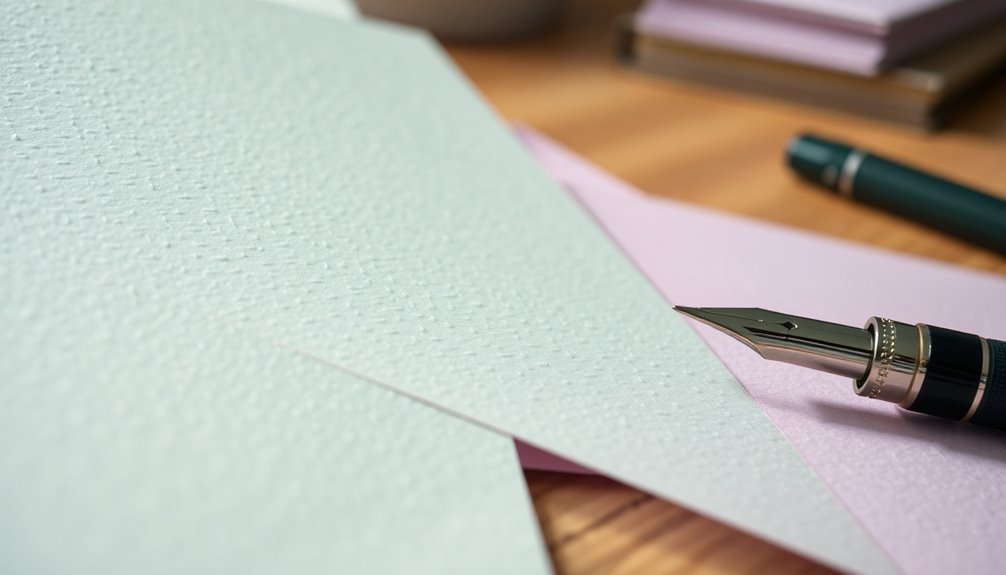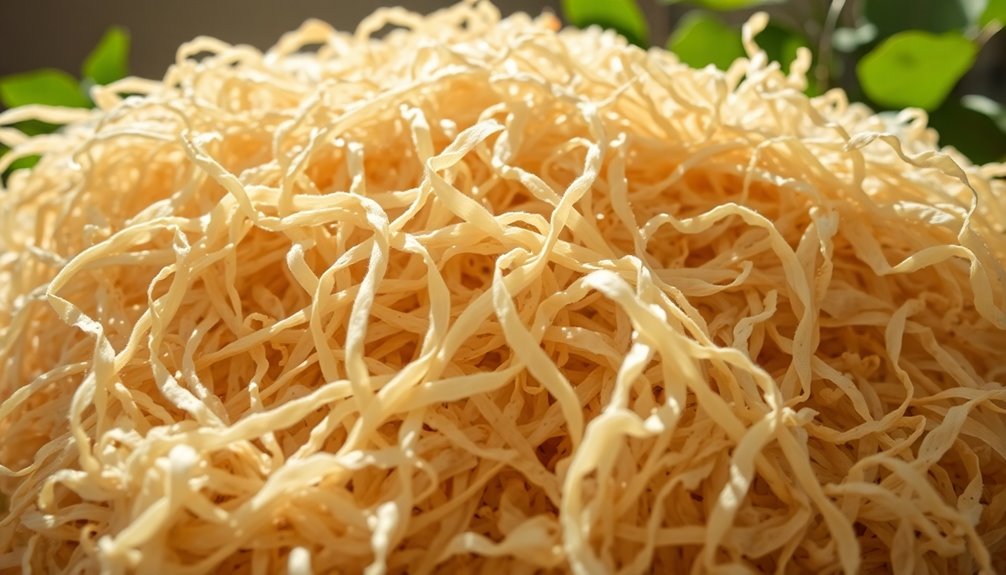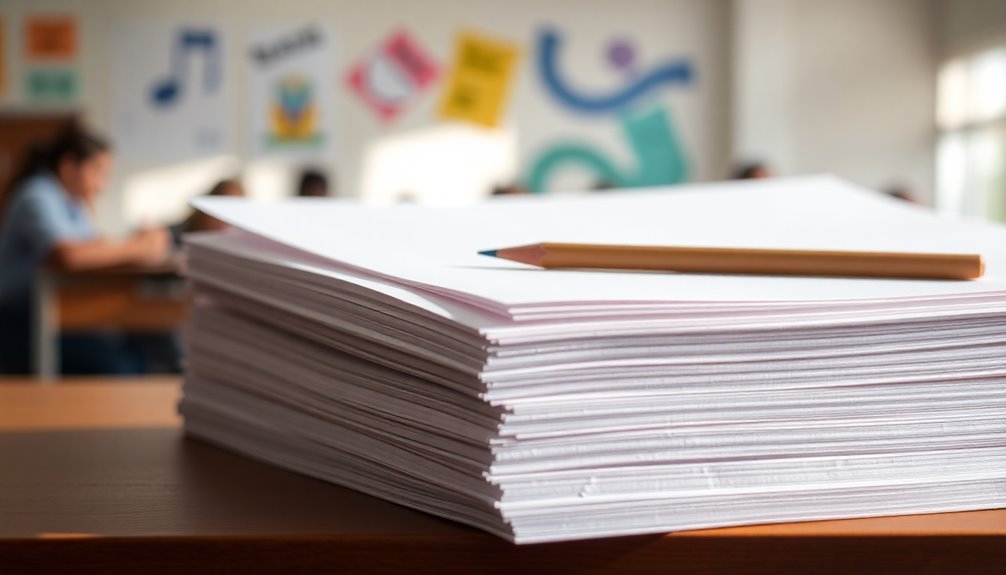You've likely noticed the buzz around 'syrefritt' papers, and it's no surprise why. These acid-free papers are designed to last over 100 years without yellowing or degrading. They maintain a neutral pH, preventing the brittleness caused by acidic materials. Plus, they're often made with recycled content, making them eco-friendly. Storing important documents in acid-free materials helps preserve your memories and protects cultural heritage. As more people recognize the benefits of these papers, the search is on for reliable options. If you're curious about how this trend impacts your collections, you'll find more intriguing insights ahead.
Key Takeaways
- Acid-free paper maintains a neutral pH, preventing yellowing and brittleness, essential for document longevity.
- Its durability can exceed 100 years, making it a popular choice for archiving important materials.
- The manufacturing process utilizes recycled materials, promoting sustainability and reducing environmental impact.
- Acid-free paper is crucial for preserving cultural heritage, safeguarding historical documents from degradation.
- Increased awareness of document preservation has sparked interest in acid-free options like 'Syrefritt' papers.
Paper Longevity Through Innovation

When it comes to preserving your important documents and creative projects, acid-free paper stands out as a remarkable innovation. This type of paper is engineered to maintain a pH level above 7, significantly reducing the risk of degradation compared to traditional acidic papers. By ensuring a neutral or alkaline environment, you're effectively protecting your materials from the damaging effects of acidity.
One of the key aspects of acid-free paper's durability is the removal of lignin during its manufacturing process. Lignin contributes to increased acidity as it deteriorates over time, leading to yellowing and brittleness. By eliminating this compound, acid-free paper enhances paper longevity, allowing it to last for over 100 years when stored properly.
Additionally, the introduction of alkaline substances, like calcium carbonate, neutralizes any remaining acids, further promoting the paper's stability and resistance to aging. Adhering to stringent standards, such as ISO 9706, ensures that acid-free paper products meet the requirements for long-term preservation. So, if you're serious about safeguarding your valuable documents, investing in acid-free paper is a smart choice that pays off in the long run.
Importance of Ph Levels

Why does pH level matter so much in preserving paper? The pH scale measures how acidic or alkaline a substance is, with a neutral pH level of 7 being ideal for paper longevity. Acid-free paper maintains a pH level above 7, which significantly resists degradation compared to standard paper that often falls below this neutral mark.
When you use non-acid-free paper, you're inviting trouble. Acidic compounds lead to yellowing, brittleness, and eventual deterioration. This degradation is exacerbated by lignin, a component of wood pulp that releases acids as it breaks down. These acids further weaken the paper fibers, making them more susceptible to damage.
To combat this, manufacturers incorporate buffering agents like calcium carbonate during the production of acid-free paper. This helps maintain an alkaline environment, preserving the paper's integrity and durability over time. By choosing acid-free paper with a stable pH, you're investing in the longevity of your documents, artwork, or cherished memories. So, next time you select paper, remember: pH levels play a crucial role in ensuring your collections last for generations.
Storage Methods for Acid-Free Paper
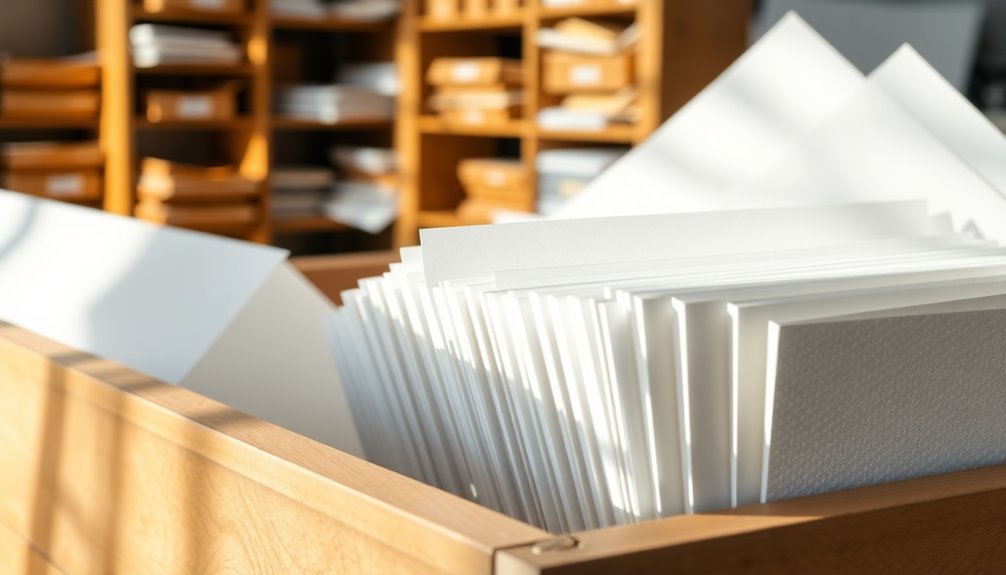
To ensure your acid-free paper stays in top condition, you should regularly store it in a cool, dry environment. Temperature fluctuations and moisture can accelerate degradation, even in acid-free materials. Using proper storage methods is essential for preserving your documents over time. Acid-free folders, boxes, or enclosures provide added protection against environmental factors and physical damage.
Avoid exposing your stored acid-free paper to direct sunlight or fluorescent light, as ultraviolet rays can lead to fading and deterioration. Keep your documents sealed away from light whenever possible. Regularly inspect your stored acid-free documents for any signs of wear or damage, so you can take action before it's too late.
When handling acid-free paper, always use clean, dry hands or cotton gloves. This prevents oils and dirt from transferring onto the surface, which can compromise the paper's integrity. By following these storage methods, you can effectively minimize the environmental impact on your acid-free paper and ensure its longevity. Taking these simple steps will help maintain its quality, allowing you to enjoy your documents for years to come.
Environmental Impact of Manufacturing
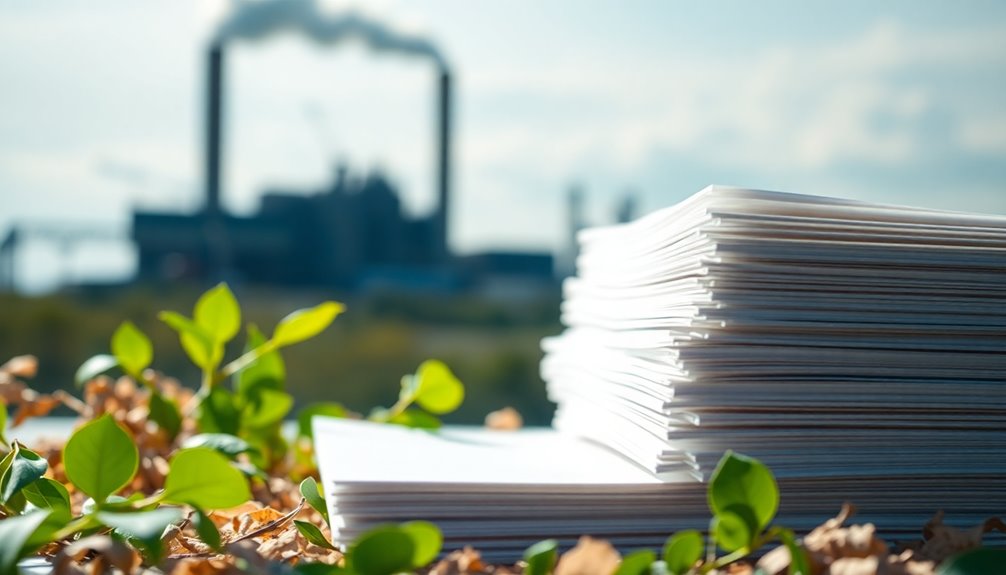
Maintaining the quality of acid-free paper goes hand in hand with understanding its environmental impact during manufacturing. The manufacturing process of acid-free paper utilizes alkaline substances like calcium carbonate, which neutralizes acids and reduces harmful effects compared to traditional methods. This approach minimizes the environmental impact by separating lignin from wood fibers without excessive chemical usage.
Moreover, many manufacturers incorporate recycled materials in their production, promoting sustainable practices and further decreasing the environmental footprint. By using recycled content, you're contributing to a circular economy that conserves resources and reduces waste. Acid-free paper also boasts longevity, meaning you won't need to replace it as often as acidic paper, leading to less consumption overall.
Adhering to stringent specifications like ISO 9706 ensures that acid-free paper meets high durability and preservation standards while maintaining minimal environmental impact. This commitment to quality not only benefits your projects but also supports a healthier planet. By choosing acid-free paper, you're making a conscious decision that aligns with sustainable practices and reduces the ecological footprint of paper manufacturing.
Historical Archives Utilizing Acid-Free Paper

Acid-free paper has become essential for historical archives, ensuring the preservation of invaluable documents for future generations. By adopting acid-free paper, you're helping to safeguard vital records that might otherwise suffer from degradation due to acidity. Traditional papers can lead to brittleness and discoloration, compromising the integrity of documents over time.
With proper conditions, acid-free paper resists degradation for over 100 years, making it a reliable choice for maintaining the quality of historical records and personal letters. Many institutions now adhere to stringent standards, such as ISO 9706, which govern the use of acid-free materials, enhancing the durability of stored documents.
This shift toward acid-free solutions isn't just about preserving documents; it also reflects a commitment to protecting cultural heritage from the detrimental effects of traditional papermaking. Moreover, by using acid-free paper, you're also contributing to a more sustainable recycling stream, as these papers are less likely to introduce harmful acids back into the environment. Ultimately, the move to acid-free paper is a proactive step that archivists and conservators take to ensure that our history remains accessible for generations to come.
Preservation of Cultural Heritage

While the passage of time threatens the integrity of cultural heritage, employing acid-free paper plays a crucial role in its preservation. This type of paper is specifically designed to prevent degradation, yellowing, and brittleness, which are significant risks for historical documents. Without acid-free solutions, these valuable artifacts face deterioration due to acid hydrolysis, making the transition to acid-free methodologies essential for long-term conservation efforts.
By choosing acid-free paper, you're enhancing the longevity of cultural heritage materials, allowing them to last over 100 years under proper storage conditions. This commitment also reflects a collective responsibility to safeguard knowledge and history for future generations. When manufacturers adhere to stringent standards like ISO 9706, you can trust that the acid-free paper meets the necessary specifications for archival quality and preservation.
Ultimately, the use of acid-free paper is not just about maintaining documents; it's about protecting the stories and legacies that shape our understanding of the past. By prioritizing preservation through acid-free solutions, you're contributing to a sustainable future for cultural heritage, ensuring that these treasures endure for years to come.
Frequently Asked Questions
What Is Special About Acid-Free Paper?
Acid-free paper's special because it resists degradation, keeping your documents safe from yellowing and brittleness over time. You'll appreciate how its pH level of 7 or above promotes longevity. The manufacturing process removes harmful lignin and includes buffering agents like calcium carbonate, ensuring your projects stay intact for years. By choosing acid-free paper, you're protecting your important items and enhancing their durability, making it a smart choice for preservation.
Why Use Acid-Free Tissue Paper?
You should use acid-free tissue paper because it protects your delicate items from yellowing and brittleness. Its neutral pH level ensures that photographs, textiles, and documents stay safe during storage. By choosing acid-free options, you're minimizing the risk of degradation over time. Plus, many of these papers are lignin-free, which enhances their stability. This way, you're not just preserving your belongings; you're also contributing to the longevity of cultural heritage for future generations.
What Are the Benefits of Archival Paper?
When you choose archival paper, you're ensuring your documents last a lifetime. Its acid-free composition prevents yellowing and brittleness, keeping your important papers in pristine condition. You'll appreciate how it withstands time, designed to last over 100 years if stored properly. Plus, by using archival paper, you're making a sustainable choice, as it's recyclable and reduces the need for frequent replacements. It's a smart investment for preserving your cherished memories.
Does Acid-Free Paper Prevent Mold?
Acid-free paper doesn't inherently prevent mold, but it can help reduce conditions that promote its growth. Since it lacks lignin and has lower acidity, mold finds it less appealing. To truly minimize mold risk, you'll need to control humidity and store your papers in dry, well-ventilated areas. By maintaining a proper environment, you can enhance the longevity of your documents and keep mold at bay effectively.

